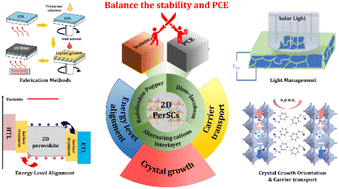Crystal growth of two-dimensional organic–inorganic hybrid perovskites and their application in photovoltaics
Abstract
The success of introducing diverse organic cations in three-dimensional (3D) organic–inorganic hybrid perovskites to form two-dimensional (2D) or quasi-2D perovskites, including Ruddlesden–Popper (R–P), Dion–Jacobson (D–J), and alternating cations in the interlayer (ACI) structures, highlights the research progress for 2D perovskite-based optoelectronic materials and devices. However, the power conversion efficiency (PCE) of 2D perovskite solar cells (PerSCs) still needs to catch up to their 3D counterparts at present. In this review, we focus on the crystallographic characteristics and crystal growth of 2D perovskites from the perspectives of fabrication methods, solvent engineering, and component engineering. For 2D PerSCs, three critical factors of carrier transport, energy level alignment (ELA), and light management are summarized to further enhance the photovoltaic performance. Furthermore, the exact balance between stability and efficiency needs to be reconsidered. The structural stability, phase stability, and environmental stability are discussed for all-inorganic, tin-based, and 2D/3D PerSCs. Finally, several new insights are proposed to further optimize the photovoltaic properties of 2D PerSCs.

- This article is part of the themed collection: Journal of Materials Chemistry A Recent Review Articles


 Please wait while we load your content...
Please wait while we load your content...